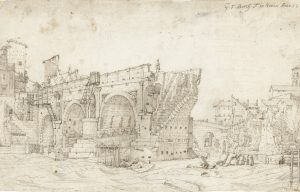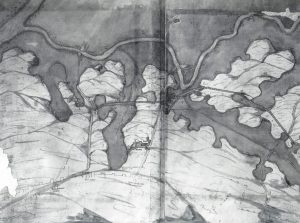Pamela O. Long
University of Chicago Press

In this erudite book, Pamela Long traces the history of engineering and infrastructural works in Rome primarily between the Tiber’s disastrous flood in the fall of 1557, which devastated the city, killing over a thousand people, and 1590, the year that marked the death of Pope Sixtus V. The era followed the wake of the final meetings of the Council of Trent and saw the ascendency of four popes: Pius IV, Pius V, Gregory XIII, and Sixtus V. Addressing a host of engineering and urban design projects in the Eternal City, Long’s fastidiously researched book presents projects that were implemented—and their subsequent maintenance—as well as ones that failed to succeed. In doing so, Long avoids a common teleological pitfall in the history of technology and science: the tendency only to narrate revolutionary inventions and physically realized projects. As she observes, her methodological approach revises research from the late 1970s and 1980s, in which scholars such as Paolo Prodi in Il sovrano pontefice (1982) depicted the Renaissance popes as “papal princes,” ruling a quasi-territorial state. Rather, as Long argues, sixteenth-century papal rule in Rome often reflected a bifurcated situation with both a communal and an ecclesiastical government. Long follows in the footsteps of Emilio Re’s early article, “Maestri di strade” published in Archivio della Società Romana di Storia Patria (1920), concerning an eponymous Magistery of the Streets, an organization that oversaw various aspects of urban upkeep. Re charted the at times fraught relationship between the papacy and the communal Roman government over the control of streets and adjacent properties, a topic Long covers extensively. Other challenges to sacred power also existed in the papal territories, complicating church control.
Long’s introduction, eight chapters, and brief conclusion are organized through themes that range from flood problems to cartography, printing, and the creation/repair of streets and infrastructure (Figure 1).
With regard to deluges, Long relays how debates focused on the Tiber’s potability, and recommendations about how to dissipate the impact of flooding proliferated in late sixteenth-century Rome. One of the most impassioned proponents of flood prevention was Andrea Bacci (1524–1600), who recommended lowering the riverbed and renewing the appointment of the office of Steward of the Tiber in his treatise Del Tevere (1558), which he revised (significantly) and republished twice. During an era when Rome reveled in the creation of scores of new fountains, as Katherine Rinne explored in Waters of Rome (2010) and which has been covered in numerous other publications, including Acque, tecniche e cantierei nell’architettura rinascimentale e barocca, edited by Claudia Conforti and Andrew Hopkins (2002), the issue of flooding—taming water—was not solved in the late sixteenth century. However, as Long reveals, practical engineering knowledge joined with university thought during the period.

In studying the history of urban development, Long demonstrates that fifteenth- and sixteenth-century bulls and edicts on Rome’s streets consistently battled filth (particularly human and animal waste), advocating for clean streets. Whereas many other accounts focus on urban interventions under particular popes, Long deploys a careful reading of archival documents and legal texts produced under several popes to unveil a profoundly readable account of bureaucratic organizations. Her work homes in on the Magistery of the Streets, which was expanded under Sixtus V both in number (from two offices to fourteen) and in the scope of its responsibilities. While her reading of issues of hygiene could be propelled by a more theoretical stance, such as looking to Mary Douglas’s observations in Purity and Danger (1966) about dirt as matter out of place, Long’s use of archival material produces a stimulating historical account of the management of streets in late sixteenth-century Rome.
One of the book’s chapters is dedicated to the repair of the ancient Roman Acqua Vergine, first initiated by Pius IV, who gave the project to Antonio Trevisi, a military engineer, much to the chagrin of Pirro Ligorio, an antiquarian and architect who also proposed designs for the endeavor (Figure 2). The plagued attempt to restore the structure dragged on over the course of Pius’s reign and was only concluded under different architects, finally with Giacomo della Porta and Bartolomeo Grippetto guiding the project (with oversight) until 1570 when the aqueduct’s water flowed into the Trevi Fountain. The chapter attends to the economics of urban and architectural interventions; for example, Long writes a fascinating account of the pricing of the water that poured into branches running off of the Acqua Vergine’s main conduit.

The book’s fourth and fifth chapters explore topographic images of the Eternal City, with a particularly compelling account of the contentious dispute between Ligorio, Bartolomeo Marliani, and other antiquarians about the location of the ancient Roman Forum (an area smaller than what we today consider to be the Forum). Long’s work on cartography calls to mind Jessica Maier’s Rome Measured and Imagined (2015). However, Long’s discussion of how print shops were important places of dialog between antiquarians adds to our understanding of how cartographic knowledge was produced and transferred in early modernity.
The last two chapters of Engineering the Eternal City focus on urban planning and the historical use of Rome’s streets. While some of the material presented is well-trodden territory (e.g., Long’s discussion of the papal possesso and the project to relocate the Vatican piazza’s obelisk), less well-known accounts of issues (e.g., debates about street paving) offer fresh details about the surface treatment of early modern Roman throughways.
As Long’s extensive bibliography reveals, engineering and infrastructure in Renaissance Rome (and elsewhere) have an extended history as scholarly preoccupations—Engineering the Eternal City has good company. Yet, unlike many other texts on the topic, Long makes the important and often overlooked point that distinctions between what we would call engineering and architectural design—in both material and theoretical realms—were far more slippery in the late sixteenth century than they are today. Scholars will find that in the depth and breadth of projects Long covers, she has made a lasting contribution to the study of sixteenth-century Rome.
Lauren Jacobi is an associate professor in the Department of Architecture, MIT. She is currently developing a book about the nomos of the sea, studying how spatial practices extended to aquatic realms in the pre-industrial Mediterranean world. She is the author of The Architecture of Banking in Renaissance Italy: Constructing the Spaces of Money (2019). It probes historical relationships between banks and religious behavior, exploring urban geographies and architectural forms that unveil moral attitudes toward money during the birth of capitalism.
How to Cite This: Jacobi, Lauren. Review of Engineering the Eternal City: Infrastructure, Topography, and the Culture of Knowledge in Late Sixteenth-Century Rome, by Pamela O. Long. JAE Online. January 24, 2020. http://www.jaeonline.org/articles/review/engineering-eternal-city#/.






